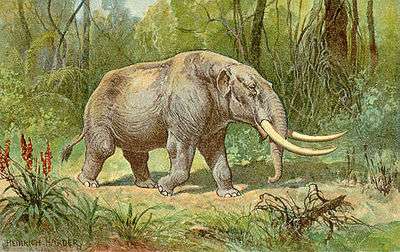Hiscock Site

The Hiscock Site is an archaeological site in Byron, Western New York, United States that has yielded many mastodon and paleo-Indian artifacts. Now owned by the Buffalo Museum of Science, it has been studied by archeological excavation and analysis since 1983.[1][2]
History
Prehistoric 10,000 years ago
Around 10,000 years ago, the site was covered by Lake Tonawanda, which was formed by runoff from the melting and receding glaciers.[3]
Accidental discovery 1959
In 1959 the Hiscock family, for which the site is named, were using a backhoe to deepen a pond. Their backhoe ripped a large tusk out of the ground. The Hiscocks contacted the Buffalo Museum of Science about the site. For a time, it did not have the resources to mount an archeological excavation.
Excavations since 1983
The first excavations of the site began in 1983 and yielded surprising specimens. Dr. Richard Laub, curator at the Buffalo Museum, formally introduced the site to the world in 1986. In 1989, the Hiscock family donated 10 acres of the site to the Buffalo Museum of Science for research. The site has been excavated seasonally since 1983. More than 200 international volunteers have worked at the site, in addition to American researchers and students.
Important finds
Prehistoric Mastodons

Mastodons are members of the prehistoric, extinct genus Mammut; they resemble modern elephants.
Native to North America, mastodons lived on the continent from almost 4 million years ago, in the Tertiary period, until their eventual disappearance about 10,000 years ago. Mastodons also lived in Europe, from about five million years ago, but died out much earlier, 2 to 3 million years ago.[4]
Mastodon fragments
Mastodon fragments such as large tusks, tusk tips, ivory, ankle bone, teeth, skull, and nural spine have been discovered in the excavations. More than 13 tusks have been found at the site. Analysis of the mastodon tusk tips has shown that the mastodons used their tusks to dig up sodium-rich clay during the last great paleo-drought.
Paleo-Indian artifacts
Evidence of paleo-Indians has also been discovered at the site, with flint knappings, stone tools and projectile point. These were bound to sticks and lances for hunting.
See also
References
- ↑ "Geology: Hiscock Site", The Buffalo Museum of Science, Retrieved on 2007-12-05
- ↑ "Excavation pit at the Byron Dig" The Buffalo Museum of Science, Retrieved on 2007-12-05
- ↑ Ernest H. Muller (1977), "LATE GLACIAL AND EARLY POSTGLACIAL ENVIRONMENTS IN WESTERN NEW YORK", Annals of the New York Academy of Sciences 288 (1), 223–233. doi:10.1111/j.1749-6632.1977.tb33618.x
- ↑ "Greek mastodon find 'spectacular'". BBC News. 24 July 2007. Retrieved 2007-07-24.
Further reading
- RICHARD LAUB, NORTON G. MILLER and DAVID W. STEADMAN (eds.), Late Pleistocene and Early Holocene Paleoecology and Archeology of the Eastern Great Lakes Region: Proceedings of the Smith Symposium, held at the Buffalo Museum of Science, October 24–25, 1986: Buffalo Society of Natural Sciences Bulletin, vol. 33, 1988
- RICHARD LAUB, ed. The Hiscock Site: Late Pleistocene and Holocene Paleoecology and Archaeology of Western New York State, Proceedings of the Second Smith Symposium, held at the Buffalo Museum of Science, October 14–15, 2001: Buffalo Society of Natural Sciences Bulletin, vol. 37, 2003
- Richard Laub, "The Paleoindian presence in the Northeast: a view from the Hiscock Site," pp. 105–121, In Kurt W. Carr & James M. Adovasio (eds.), Ice Age Peoples of Pennsylvania, Pennsylvania Historical and Museum Commission (in coop. with the Pennsylvania Archaeological Council), 2002
